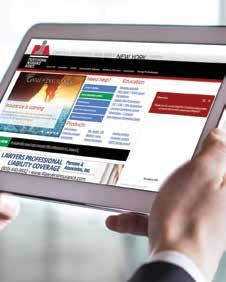

PAGE 20 OPTIMIZE MORE ORGANIC GROWTH October 2022 • Vermont 9 Consider mid-career professionals 15 A culture of well-being 25 New hires have new expectations IN THIS ISSUE 9 Distorted patents, exorbitant premiums 15 Avoid a ‘slow time’ sales slump 25 A new face for your agency IN THIS ISSUE

Find out more at concordgroupinsurance.com THE SPEED OF SMALL BUSINESS IS ANYTHING BUT SLOW Help your clients keep their auto repair shops running like a well-oiled machine with our broad coverage options and additional enhancements.
Statements of
in
President and CEO Jeff Parmenter, CPCU, ARM; Executive Director Kelly K. Norris, CAE; Communications
Katherine Morra;
Jaye Czupryna; Advertising Sales

Calley Rupp;
Cancio,
Postmaster:
NY 12077-0997.
“Professional Insurance Agents” (USPS 913-400) is published monthly by PIA Management Services Inc., except for
Agents, 25 Chamberlain St., P.O. Box 997, Glenmont, NY 12077-0997; (518) 434-3111
July/August
(800) 424-4244; email pia@pia. org;
Wide
©2022
address: pia.org.
at Glenmont, N.Y., and additional
COVER DESIGN
Anne Dolfi
October 2022 • Vermont COVER STORY 20 Project a marketing-focused culture Optimize more organic growth FEATURE 25 A new face for your agency PIA can help you be more memorable DEPARTMENTS 4 In brief 9 Legal 15 Sales 29 E&O 31 Ask PIA 34 Readers’ service and advertising index
fact and opinion
PIA Magazine are the responsibility of the authors alone and do not imply an opinion on the part of the officers or the members of the Professional Insurance Agents. Participation in PIA events, activities, and/or publications is available on a nondiscriminatory basis and does not reflect PIA endorsement of the products and/or services.
Director
Editor-In-Chief
Executive
Senior Magazine Designer Sue Jacobsen; Communications Department contributors: Athena
David Cayole, Patricia Corlett, Anne Dolfi, Crystal Ringler and Lily Scoville.
Send address changes to: Professional Insurance Agents Magazine, 25 Chamberlain St., Glenmont,
a combined
issue. Professional Insurance
or toll-free
World
Web
Periodical postage paid
mailing offices.
Professional Insurance Agents. All rights reserved. No material within this publication may be reproduced—in whole or in part—without the express written consent of the publisher.
Automate social-media marketing
Automation plays a significant role in our lives. Of course, much of it is technology based. Moreover, it is a central driver within our professional, independent insur ance agencies. It helps agency owners and employees work smarter. Done right, it saves us time and money.
Where many agencies fall short is in the use of automa tion for social-media marketing. Such automation brings efficiencies. The balance is how to automate a socialmedia presence and remain engaged in a conversation with your audience. Remember, social-media marketing does not begin and end with automation.
Social-media marketing automation can schedule posts for specific days and times. However, you need to be engaged in the process from start to finish. Using tools won’t eliminate work; it simply helps you operate more efficiently—reducing what could be several hours of work each day to as little as 30 minutes—and it helps ensure a profitable online marketing outcome.
To build and implement an efficient and productive social-media marketing process, you need to combine the ingredients—personal brand ambassadorship and effec tive automation deployment—and then check progress. Here are four steps to make automation-enabled socialmedia marketing easier:
Step 1: Automate or not? It’s vital to understand when and what to automate and when to engage in the socialmedia world. Automation can be addicting. Once you unlock its efficiencies, it’s tempting to add more. Resist the temptation and do not automate every message.
Progressive Insurance learned this lesson a decade ago when it automated Twitter responses after a claims story went viral (“Progressive Robo-Tweets Spark Social-Media Crisis,” CNN.com).
Instead, automate nonurgent social posts. Start with content you’ve discovered and gathered from various sources. Finding and sharing content online is a great way to build your agency’s brand and to grow your social audience. Content from others should make up about half of your content posts.
Follow the “5-3-2” rule. The “5” refers to the number of posts out of every 10 that are from others and then shared with the relevant audience. The “3” refers to rele
vant business content generated by your own agency. The remaining “2” should be personal, nonwork-related content that helps humanize the agency and builds its brand among your relevant audience.
Notice how the term “relevant” appeared repeatedly in the previous paragraph. You need to post content on platforms that will reach the right audience and with the right content at the appropriate times.
If your audience comments on a post, you need to engage with it. Nobody likes to be ignored. In fact, when you ignore someone in the social world, your entire platform community sees your lack of response. This can lead quickly to your agency earning the reputation of being rude and socially unacceptable. Many businesses, including insurance agencies, want to automate their Rich Site Summary feeds. Bloggers often want to share their latest posts in the social world. Automation is a helpful tool with this—allowing you to transmit blogs directly to selected social-media channels. The only catch is that you want to check formatting on every blog post.
It’s important to be aware of, and respond to, feedback with RSS content, just as it is with other messages you share. Blind blasting—creating a one-way conversation— screams automation and it is a major audience turn-off in the social world.
Do not automate customer interaction. Automating more than an acknowledgment or a simple “thank you” is dangerous. Customers appreciate individual responses on social platforms. In fact, this personal interaction is what makes social media so powerful. You should never take the human side out of social media.
Do not automate troubleshooting. Real situations require real people with real answers. There may be opportunities to streamline some agency communication—common problems are fixed with simple answers. Even then, it’s best to run it by a human first.
Step 2: Pick a tool. It’s important to choose the right automation for your agency’s social marketing. The most popular sharing tools are Zoho Social, Buffer and Hootsuite. The tools integrate with Facebook, Twitter, LinkedIn, Instagram and more.
(continued
IN BRIEF PROFESSIONAL INSURANCE AGENTS MAGAZINE4
on page 6.) FYI
Chris Paradiso, owner, Paradiso Financial & Insurance Services
BLOGS, VIDEOS & PODCASTS


as an authority in the
use increased by 1,355%. Thirty-one
go online several times a day. Each month,


BLOGS

VIDEOS
PODCASTS

More than 160 million
HALF OF THE U.S.
MONTH
MOST POPULAR
Popular times for
between 8:15-8:30 a.m.
popular times: between 11-11:15 a.m., and at 5:30 p.m.
THE LATEST:
LISTENING TIMES:
podcast listening
Other
people have listened to a podcast.
ALMOST
POPULATION LISTENS EACH
More than a quarter listen to podcasts weekly. More than three-quarters listen to them on their cell phones. The majority of customers say they would rather learn about a product or service via video. More than half of consumers want to see more video content from a brand or business they support. 30% of marketers use video messaging in nurture campaigns. Marketers who use video grow revenue 49% faster than non-video users.
Those who prioritize blogging are 13x more likely to have a positive ROI on their e orts. Seventy-seven percent of internet users read blogs. Businesses that blog get 97% more links to their websites. MOST POPULAR BLOG HEADLINE FORMATS: 1. Headline that starts with a number 2. Headline that addresses the reader “why you need to buy insurance” 3. Headline that starts with “how to” 4. Basic headline “ways insurance can provide peace of mind” 5. Headline that asks a question Almost half of nurture campaigns feature thought-leadership blog posts. Have you looked at your agency’s website lately? Is it engaging and an extension of your agency’s brand? Or, does it simply serve as
a
way to host your agency’s contact information? Did you know that by adding blog posts, videos and podcasts to your agency’s website, you can increase engagement with your current and prospective clients? They also can help position you
insurance industry. From 2000 to 2022, the world population’s internet
percent of U.S. adults admit to being online “almost constantly,” and 48%
409 million people view more than 20 billion webpages. PIA.ORG 5
With Buffer, you can place the content you find into a queue and generate agency posts throughout the week. By default, Buffer spaces posts out throughout the day and throughout the week. At the same time, it allows a user to get ultra-specific on the day and time of the posts.
The tool comes with various features to help make updates easier. For instance, there are browser extensions to share content right from within a webpage. There are tablet and smartphone applications to share content from those devices in a few simple steps.
An important feature in Buffer—and other tools—is an analytics dashboard. When you use it, you can see what posts are read, clicked, liked, shared, commented on, etc. Learning this information can help you build even stronger content going forward.
Searching “social-media automation tools” in your web browser will return hundreds of options. Explore them. Be sure to look at Hootsuite, Buffer and any others that seem appropriate to you. When you make your choice, be sure to look for a tool that’s easy to use and that can be implemented with a short learning curve.
Step 3: Establish a schedule. You need to figure out your agency’s ideal automation schedule. The most important question to ask is: “When will I be around to respond to my audience if and when it engages with my content?”
Because two-way interaction is integral to success on social platforms, you want to be able to see and respond to the activity of your followers. Don’t forget time differences; if your agency operates in multiple time zones, consider what effect that will have on your posts’ exposure.
In addition, you need to understand when people click on, or otherwise interact, with your posts. This helps you gauge high-engagement times and allows you to schedule future posts when more people will see and connect with your content. There are several tools to help you analyze when people engage with your tweets (e.g., Follower wonk, Tweriod and SocialBro).
Step 4: Engage, learn and improve. Sustaining a socialmedia marketing strategy requires a system to allow you to stay in the conversation, such as Mention, which lever ages Google Alerts, to track your agency’s website; the names of your agents; your blogs and other content across all social-media channels.
Mention emails you when your agency, or anything you track, receives a mention in the social world. You can access the service from any device and monitor—in real
time—anything published on social networks, news sites, forums, blogs or any other webpages.
Don’t forget to turn on all social-platform notifications to be aware of engagement opportunities. Twitter, Facebook and other channels will notify you anytime anything happens with your accounts.
Another part of engagement is time. Be sure your agency sets aside time to interact. Social-media conversations represent a great way to unearth new business opportuni ties and to build relationships with existing customers, which helps at renewal time.
Use what you learn to enhance what you’re doing. Adapt to what the data tells you. Bolster your content based on audience responses. Shift your timing, if needed. Then, monitor and repeat the enhancement process.
Make it work
Following this process will help your agency save time and money on your social-media marketing strategy. As you implement these steps, it’s important to avoid the pitfalls of automation.
First, don’t take a one-size-fits-all approach. Make sure you customize your messages for different social networks. Recognize the difference between business-tobusiness and business-to-consumer platforms and drive content accordingly.
Second, don’t make timeline mistakes. Scheduling posts too far out may lead to you sharing untimely content or, worse yet, missing opportunities for timely engagement. Finally, don’t assume the social world starts and ends in your agency. Stay updated on current events and take opportunities to leverage them in all your social content and with all your audiences.
Take the right steps—and avoid certain missteps—then you’ll see increased activity, more business, and a greater return on your social-media marketing investment.
Paradiso is owner of Paradiso Financial & Insurance Services in Stafford Springs, Conn., which received the National Association of Professional Insurance Agents 2013 Excellence in Social Media Award. He formed Paradiso Pres ents LLC to teach agents how to survive in today’s complex online marketing world. The firm specializes in educating agents, carriers and associations on a range of branding, online, social and management strategies. For more infor mation and to learn about upcoming seminars, visit www.ParadisoPresents.com.
PROFESSIONAL INSURANCE AGENTS MAGAZINE6 (continued from page 4.)FYI



You’l l l ike us because t here’s nobody l ike us. Workers Compensation Insurance • No volume requirements • Competitive rates • Multiple options for premium payments • Open to Shock Loss/High Mods Send in your submissions today. For more information contact a marketing rep at 844-761-8400 or email us at Sales@Omahanational.com.[ Coverage in: AZ • CA • CT • GA • IL • NE • NJ • NY • PA Smart. Different. Better.Omaha National Underwriters, LLC is an MGA licensed to do business in the state of California. License No. 078229. Coverage is provided by Preferred Professional Insurance Company and/or Palomar Specialty Insurance Company. Coverage may not be available in all states.
Distorted patents and exorbitant premiums

In June 2014, Tesla CEO Elon Musk posted a blog on the company’s website announcing the company would treats its patents as open-source designs to encourage more companies to build and sell all-electric veIn typical Musk fashion, the blog post raised more questions and caused some concern for investors with the patents key to Tesla’s value as a company. And, what would be considered “good faith” application of

Missing in the explanation of the decision was that patents are intended to bridge the gap between open-source information and intellectual property rights to promote innovation. Tesla may have successfully obtained several patents for the innovation technology related to electric vehicles, but those innovations became public as part of the patent. For 20 years, Tesla would be
able to use the patented technology in its products exclusively before it would enter the public domain. In the meantime, other companies could review the patented products, but they would need to develop their own parts for electric vehicles. This balance gave Tesla a competi tive edge while providing the rest of the market updates to further their own innovation.
PIA.ORG 9 LEGALCLARE IRVINE, ESQ. Government affairs counsel, PIA Northeast
www.tagcobrand.com/pia Learn more: New PIA Northeast Member Benefit 401(k) Plan Should Be A Major Reason Why People Want To Work For You Attract better employees and retain them longer by offering the security of a great 401(k) plan. With PIA Retirement Plan and TAG Resources you can offer your employees an amazing benefit without taking on the day-to-day responsibilities of looking after a 401(k) plan.
While Musk may have missed that patents already were intended to share technology, he did elaborate that patents had too frequently become used to “stifle progress” and “enrich lawyers.” As technology became more advanced and patents more valuable, major corporations had turned to courts to defend their patent rights. For small or new businesses based on patented technology, the costs of defending such lawsuits can quickly subsume the company.
The origination of patents
Patents always have been part of the United States legal system, created in 1790 as one of the first ever acts of Congress intended to “promote the progress
of science and useful arts.”2 President George Washington signed the first U.S. patent on July 31, 1790, for a method of making potash and pearl ash.3 By the time the U.S. began to number patents in 1836, 9,957 had been issued.4 With patents, the inno vation would be shared and promote further development.

In addition to promoting innovation, patents also have a role in promoting entrepreneurship by giving inven tors ownership over their creations and discoveries. Ordinary Ameri cans could tinker around and create something they patented, then try to sell the new widget. For a set period of time, no one else could manufac ture that specific widget with the same design.
Publication of designs is a crucial part of patents. For businesses that prefer to keep their intellectual prop erty confidential, then they must rely on trade-secret law. Companies may choose to keep drink formulas and algorithms private via contracts and trade-secret law while still filing for patents for key technology. Eventu ally, the patented technology would enter the public domain while the trade secrets outlast statutory limits, so long as the company protects its proprietary information.
Costs of patent defense
As technology has gotten more complicated and patents increas ingly valuable to companies, the costs of defending patent rights have skyrocketed. Apple and Samsung demonstrated the importance of patents in their competition with each other when they spent seven years and hundreds of millions of dollars filing lawsuits against each other for patent violations.5 In the
PROFESSIONAL INSURANCE AGENTS MAGAZINE10
Please refer to actual policy for details. Policies are underwritten by Great American Insurance Company, Great American Insurance Company of New York, Great American Alliance Insurance Company, and Great American Assurance Company, authorized insurers in 50 states and the DC. Products not available in all states. © 2022 Great American Insurance Company, 301 E. Fourth St., Cincinnati, OH 45202 5633-AGB 10/22) Bow, NH 877.552.2467 aimscentral.co m TM FROM THE FARM AND RANCH PROFESSIONALS AT WHY BE GOURD WHEN YOU COULD BE GREAT?
end, neither company gained a significant competitive advantage and the undisclosed settlement between them likely constituted a rounding error on the balance sheets.
Such battles between multinational corporations may be a fair battle— albeit one lawyers primarily benefit from—but the risks and costs get distorted when a smaller corporation attempts to take on such a giant.
For several years, speaker company Sonos has been in a legal battle with Google over patents related to its speaker technology. Previously, Sonos had shared patented designs with Google as part of discussions to integrate Google voice-assistant technology into the speakers. With the designs patented, Sonos likely believed that its technology was legally protected, and Google always could have obtained the designs outside discussions. Initially, the U.S. International Trade Commis sion ruled in favor of Sonos, but the company has run into a bigger issue—Google has the funds to keep fighting.6 In August 2022, Google filed its own patent infringement lawsuit against Sonos, which Sonos deemed an “intimidation tactic.” 7 Aside from the highly technical and legal arguments, the continued costs of lawsuits surely will cause increased stress on Sonos against a company with far more resources.
Insuring patents
The high costs of patent litigation and increasingly technical patents have caused the price of patent insur ance to reflect the costs related to patent defense. A company such as Sonos that is known primarily for products using similar technology (interconnected speakers), then protecting that patent is crucial to the value of the business. Like any
potential risk to a business, insurance offers a protection to reduce the poten tial costs in the future.
The costs start with the application. The public nature of patents makes it possible to better evaluate the potential exposure by reviewing the protected patent and other patents filed, both in effect and those already in the public domain. Unfortunately, the technical nature of modern patents requires expertise that drives costs up before a patent holder can consider the details of the policy.
Many insurance policies focus on defense from lawsuits, in which the coverage is triggered by another party filing a lawsuit. While this option exists in intellectual property and patent insurance, offensive patent insurance offers increased protection. Sonos had to file lawsuits to defend its patented tech nology against infringement by Google—only for Google to then file lawsuits against Sonos. If Sonos had patent insurance, it would need both offensive and defensive coverage to begin to defend its patents. For a company such as Sonos, the patented technology is essential to its products and business. High premiums for a potential insurance policy would prove essential to protect the foundation of the company.
What to do about Tesla?
Tesla claimed it would not file lawsuits against any company using its patents in good faith. That being said: No company should base its core products on technology patented by Tesla. Simply asserting it would not take legal action does not actually mean Tesla has waived its right to assert ownership over its intellectual property. That risk alone would likely make it impossible to obtain patent insurance—after all, a patent is required to even consider insuring it.
What is clear is that the costs of patents and their subsequent defense mean at-home tinkers may simply keep their inventions at home.
Irvine is PIA Northeast’s government affairs counsel.
1 Tesla, 2014 (bit.ly/3pDuoCK)
2 U.S. Capitol Visitor Center (bit.ly/3R4lDNp)
3 Wired , 2008 (bit.ly/3cclUzf)
4 Ibid.
5 New York Times , 2018 (nyti.ms/2Kszvmc)
6 New York Times , 2021 (nyti.ms/3K9Jidk)
7 The Verge , 2022 (bit.ly/3dH13V3)
PIA.ORG 11

We’ll Navigate Your E&O Coverage You Focus on Business Get Your Quote Call (800) 424-4244, ext. 408 | Web www.pia.org Why PIA Is the Best Choice for E&O • Our professional liability and cyberliability programs are designed for your agency’s needs and risk exposures • Critical coverage options—especially important when many agents are working remotely • Top-rated, stable E&O carriers • Experience & expertise from our team PIA is here to help you navigate through uncertain times, so let’s make sure you have great errors-and-omissions coverage at a competitive price.
Brooks is proud to support Professional Insurance Agents (PIA)

BROOKS IS HERE FOR YOU. How can we help you? Call us at 732.972.0600 or email us at info@brooks-ins.com Brooks Insurance Agency | A Venbrook Company • 70 Bridge Plaza Drive, Manalapan, NJ 07726 • 732.972.0600 • www.brooks-ins.com Brooks Group Insurance Agency, LLC | NJ License 1575143 © 2022 Brooks Insurance Agency, LLC is a wholly-owned subsidiary of Venbrook Group, LLC. All Rights Reserved.
Since its founding in 1991, Brooks Insurance Agency has successfully serviced the standard markets and brokered distressed and complex lines of business. We are here to help agents find the coverage their clients need. We represent 80+ quality carriers, including several new and exciting markets, across the country. Plus, a broad array of products and services in admitted and non-admitted markets. MARKET STRENGTHS AND EXPERTISE • Broad market reach • High-touch broker specialists • Easy, online quoting process • Collective approach to complex insurance needs

Agency Management System Transform your agency with an insurtech partner who provides a remarkable experience through its commitment to transparency, stability, collaborative innovation, and community. Learn more at hawksoft.com/purplecow The Purple Cow Experience There’s something much bigger than software going on at HawkSoft...
Avoid a ‘slow time’ sales slump this holiday season

No matter the industry or organization, they all seem to have historically slow times of year—the holidays and summer usually are the biggest. In addition, changes in the economy, the market or industry, pandemics, and supply-chain issues also can lead to slow sales. That said, there are some things you can do about it.
You don’t have to simply accept your fate as most companies and salespeople do. Yes, this is going to require you to have an open mind. All I’m asking you to do is consider what I have to say. Worst-case scenario: nothing changes. Best-case scenario: you sell more and make more money. Either way, there is no downside to reading this article.
During down times
Be a contrarian. One study I conducted found that salespeople cut calls and activity by 37% when there’s a hiccup in the economy or market. These salespeople also cut activity in perceived slow times: around the holidays, Friday afternoons, Monday mornings, and other times when they believe their business is season


Hiring
PIA.ORG 15 SALESJOHN CHAPIN President, Complete Selling
To access, visit “Tools and Resources” at pia.org
made easy Let PIA help with your staffing needs! We’ve created the Agency Staffing Assistance Program—an online member service that helps you find and keep good employees. 116225 919
ally or otherwise slow (like the summer). According to my research—early in the pandemic—salespeople cut activity by an average of 64%. When your competitors are cutting back, this is the perfect time to make more calls and get more business. These also are times when it’s typically easier to get to decision makers. Either way, you will set yourself apart and get paid for doubling efforts.
When there are supply-chain issues, people need to order sooner even during slow times. It’s also an opportunity for them to buy more than typical, to make sure they have enough down the road just in case the supply-chain issues continue. When sales are slow, use customer sales incentives that you usually use at the end of the year or end of the quarter. Look for incentives for people to buy now.
Change your vacation schedule. Instead of two weeks straight, take one week now and one week at another time. The longer you are away from selling, the more likely that bad habits will take over and erode your sales skills. On this note, it’s a good idea to prospect every day, or as close to every day as possible. If you only prospect Tuesday through Thursday, it’s going to take you several calls to get back into rhythm after four days off.
Track your activity. Track initial calls, follow-up calls, contacts, what happened on those calls, proposals, closed sales, etc. You need to track every thing you want to improve to see where you are effective and where you are ineffective. Paying attention to these items usually leads to you doing more of them and getting better at them.
Work harder, work smarter, and work longer hours. The average person will spend years looking for shortcuts rather than taking the tried-and-true path. If you make more calls, you’ll make more sales. Simple. Also, if you look for better and more efficient ways to do things, you’ll find them and save time, effort, and energy—and be able to put that into better and more prospecting.
Use incentives. If you’re a sales leader, have incentives or contests for your salespeople. My best sales quarter ever occurred one year in the months of June, July and August—even though that was typically our slow time— because there was a contest for the top 10 sales representatives in the country to win a lavish trip to Las Vegas.
Don’t overestimate the down time. Regarding holiday season or summer, your buyers don’t go on vacation all winter or summer—usually it’s just a couple weeks. There’s still plenty of time to get to people. And overall, holidays and summers tends to find people in better moods, which leads to more busi ness. This also is true for Friday afternoons.
Set a goal. Challenge yourself to sell more during the holidays, summer and at other slow times. Compete with other salespeople. Treat it like a game. Set higher standards for yourself regarding initial calls and follow-up calls, and find someone to hold you accountable to those new standards.
Identify examples. Look for other companies in your industry, and in other industries, that always seem to perform well at the holidays and at other typical down times. Look for salespeople like this, too. In both cases, find out what they do differently from everyone else.
Here are a few other ideas for slow times:
• Brainstorm as a sales team for ways to sell more, and sell more efficiently and effectively.
• Use slow times to get better at selling. Whether individually or as a group, take time to take sales courses, read books, roleplay more—and in general, learn more about sales and selling.
• Use slow times to upgrade your technology and learn how to use it more effectively.
Finally, challenge your beliefs. Remember, whether you believe you can or, you believe you can’t, you’re probably right. Challenge the old assumptions and beliefs about slow sales times.
Out of all the people and agencies in your industry, there are those who are selling more at these times. They aren’t special. If they can sell more, you can too.
Chapin is a motivational sales speaker, coach, and trainer. For his free eBook: 30 Ideas to Double Sales and monthly article, or to have him speak at your next event, go to www. completeselling.com. He has over 34 years of sales experience as a No. 1 sales rep, and he is the author of the 2010 sales book of the year: Sales Encyclopedia (Axiom Book Awards). Reach him at johnchapin@ completeselling.com.
PROFESSIONAL INSURANCE AGENTS MAGAZINE16



AmGUARD • EastGUARD • NorGUARD • WestGUARD We distinguish our Workers’ Compensation coverage by providing value-added services before, during, and after a claim. Upfront loss control measures Responsive claims handling Facilitation of quality medical care (when an accident does occur) We’ve been successfully protecting our policyholders and their employees since 1983. Browse all of our products at www.guard.com Our Workers’ Compensation policy is available nationwide except in monopolistic states: ND, OH, WA, and WY. APPLY TO BE AN AGENT: WWW.GUARD.COM/APPLY/ Focus on Professional Offices Workers’ Compensation

(800) 424-4244 | memberservices@pia.org As work environments shift and evolve, your PIA member-exclusive market access can entertain hundreds of class codes, offer a low minimum premium, and provide quick turnaround. Let our expertise and knowledge in the WC market work for you and your small-business clients. PIA’s NumberONE Comp market is now entertaining artisan classes, such as: • Landscape gardening—excluding hardscape • Plumbing NOC • Electrical wiring • Ceramic tile • Cabinet work installation • Concrete and cement work • Painting NOC—interior only Other classes include offices, restaurants, beauty shops, retail stores, doctors/dentist offices, and more. Your Clients are Getting Back to Business PIA's Monoline Workers’ Compensation Program is Here to Help In partnership with
Ask PIA hits last year
“Information, Education, Legislation! PIA—a great way to do business.”
—Nicholas Fanelli, CPCU, CIC, CLU Newberry Insurance Group
“I appreciated the detailed response. As usual, the PIA Industry Resource Center is very helpful regarding delicate matters.”
—Daniella Kirfeld Interwest United Insurance
“You are a real difference-maker for brokers on the front lines. You provide invaluable technical insight when we don’t know where to turn, which helps us compete with larger brokers and—most importantly—serve our clients.”
—Gregory C. Niccolai Madison Insurance Group

PIA’s highly qualified technical specialists can answer: • Legal • Industry • Coverage • Legislative • Regulatory … and other questions fast! PIA offers a searchable database of previously asked member questions answered by our highly qualified specialists.
2,054
144-P-2022 Log on to pia.org/IRC/askpia.


OPTIMIZE MORE ORGANIC GROWTH PROFESSIONAL INSURANCE AGENTS MAGAZINE20
Regardless of their size, independent agencies track various metrics as a scorecard of the firm’s progress. The most common one is policies in force, or PIF, which tracks the agency’s paid policies. An agency’s PIF relates to persistency, which measures policy renewal ratio. The other important metric is organic growth, measuring the increase in new business that was not purchased or acquired through a merger or acquisition.

LAURA PACKARD Senior
Vice President, Aartrijk
PIA.ORG 21
Of course, there are other metrics agencies use, but persistency and organic growth serve as the basis for the firm’s success. For most established independent agencies, the persistency ratio is healthy and above 90%. However, they often struggle to achieve organic growth targets. This can be especially true in economically stagnant areas of the country that are not growing; thus, capturing new business is essentially a zero-sum game.
So, what’s the culprit for most who struggle with organic growth?
If there is a single hallmark of running an independent insurance agency, it is the ability to multitask. Of course, being multitalented can be a blessing and a curse. If you were to write what your actual job description is, based on what you do daily, it might read as such: “… operations, human resources, recruiting, technology, service, insurance technician, carrier liaison, marketing, sales and community involvement …”
Let’s take a step back and ask the question: Where is agency revenue primarily derived from?
For most independent agencies, the answer is commission income. Yet all the above duties relate to a means, not an end. Most agencies get paid to sell policies by insurance carriers. The various duties constitute the ingredients for a successful agency, but ultimately, income is predicated on closing sales. Sure, duties can be shared, but the agency manager is busy keeping the trains running—while the customer service representatives are handling clients and producers are selling and maintaining relationships.
So, who is tasked with overseeing marketing on a consistent basis?
Before answering that question, you need to consider the relevance of setting a marketing budget for the agency.
Consider the marketing spending
Among industries, there’s a wide range in the level of marketing expenditures as a percentage of revenues. Typically, consumer-packaged goods are at the highest end, ranging from 20% to 25%. Consumer services are not far behind, at about 15%. Insurance and financial services marketing budgets range from 4% to 8% of revenues. Other industries fall in between that range.
So, in addition to pondering who should be tasked with overseeing the agen cy’s marketing initiatives, committing to investing a meaningful amount to the marketing line item is critical.
Certainly, over the years independent agencies have budgeted for marketing. But, the nature of the expenditures have—or should have—evolved along with the advent of digital marketing and social media. Most independent agencies employed a sales-driven culture more than a marketing-focused one. Tradi tionally, most of the marketing budget was synonymous with advertising, and the customary mix consisted of Yellow Pages and ads in the student yearbook and local newspaper. Funds were directed toward local charities and amateur sports—Little League baseball or Pop Warner football. That approach was tried-and-true and served many agencies well for generations.
Then, the world was turned upside down with the advent of the internet and digital marketing. Strategy and tactics now were required. In the battle between David and Goliath, David traded in his sling shot for digital marketing to
generate SEO traffic. This leveled the playing field by creating relevant, insightful content that was supple mented by a cohesive and consistent digital marketing effort.
By now, agency managers know they should have a relevant, on-brand website as table stakes. Maybe it’s interactive and has some neat features. But, is that going to achieve the firm’s organic growth targets in and of itself? Nope.
Do you have a powerful agency management system? How is that being used? Operationally? Do you have the management system inte grated with your customer relation ship management software, working together in an efficient way? Possibly. What about creating drip-marketing campaigns and relevant content that resonates with consumers? Now you’re getting it.
Stepping into the marketing role
You are likely the agency’s chief marketing officer—intentionally or by default. Now the questions are: What’s your focus and budget? And, what do you outsource? Thankfully, InsurTech is continually evolving new tools to aid the cause. An agent should look at his or her agency’s marketing budget the same way a drug company looks at R&D. If you don’t invest, the pipeline dries up.
Also, your carrier partners want you to invest and devote the effort to expanding your digital marketing reach. Ironically, if you develop a well-thought-out plan and execute on it, carriers usually will pick up some of the costs. Their frustra tion is when their offer of tools and resources go unused.
Things are changing, however. In PIA’s 2022 Independent Insurance
PROFESSIONAL INSURANCE AGENTS MAGAZINE22
Agent Survey, agents were asked, “How important is it that your carrier partners offer each of the following …?” The No. 1 affirmative response by agents was Marketing and Sales Support (71.4%).
Independent agents tout that their choice of carriers provides a compet itive advantage over exclusive, or captive, agent companies. Sure, but do consumers know or even care?
Right or wrong, “ease of doing busi ness” seems to be trumping every thing these days.
As CMO, you should focus on your agency’s brand advantage —not just your competitive advantage of offering multiple companies.
When you consider your brand advantage, don’t fall into the trap of assuming it corresponds to size of the agency or its length of tenure on Main Street. Your brand advantage relates to having a consistent, welldeveloped marketing strategy that conveys your agency’s essence and resonates with your target customers about what they value, not so much what you value.
What do your customers value?
Have you asked your target audience what they value most? If they say it’s only price, it’s time to get a new target audience.
The exclusive agency companies spend billions of dollars annually to tout their brands, but are they unique brands? Lowest price? No. Unique policy form? No! Ease of doing business? Now you’re getting warmer. Recognizable brand? That helps, but most independent agency companies are appointed with one or two of the largest exclusive agency carriers and/or direct writers.
Now you’re back to your competitive advantage because your agency is a house of brands. And, that doesn’t mean you’ll write the biggest carriers, as there may be smaller companies that are a better fit for your client’s needs. However, it does allow the agency to piggyback on the massive ad outlays by the large carriers in promoting their brands.
Agents must pivot and explain that they offer a choice of companies to meet the individual needs of the consumer. Most consumers want choice, but they also seek ease of doing business in quoting, issuance and servicing. The inde pendent agency recipe of choice, expertise and a relationship must be tweaked to embrace the efficiencies that InsurTech now provides to compete with the direct writers.
Independent agency carriers recognize that a rising agency tide lifts all their boats. If you want your firm to ride the new wave, be sure to prioritize the job as agency CMO. Designate someone who will devote the time, energy, curiosity and passion to get the strategy done—and have the budget to execute on it. The CMO also should realize he or she is not rowing the boat alone. Rather, the CMO should serve as the marketing coxswain—the one at the helm of the boat helping everyone in the firm steer together to get the job done.
SEO: Musts for independent agents
Once you’ve given thought to your agency’s metrics and your marketing budget and plan, don’t forget about your website’s search-engine optimization. Your clients and prospects are searching for you on the internet. How easy (or difficult) is it to find you? If you want new business, SEO is something that cannot be ignored. And even if you’re doing all the right things, it’s not some thing you can set and forget. Consistent, constant attention must be paid to ensure your SEO is on track.
When you are thinking about your SEO, ask yourself these questions:
• Are you publishing keyword-rich, relevant content on a regular basis? Blogs and longer-form articles can help with this.
• Does your site have a sitemap? And, is it indexed properly? If the answer is no to either or both these questions, the Google crawlers will have a tougher time finding content on your site. And, your rankings will suffer.
• Have you avoided a TKO (technical knockout)? Someone at your agency—or your marketing partner—should be familiar with the technical components of SEO and how your site can flourish. Things like website load time, keyword cannibalization, redirect chains, robots, meta-data and internal links are all critical, though not glamorous. Ignore them and your agency could be completely invisible in searches.
Forget the latest rage of crypto investing and all the other current trends. Your best investment is in your agency when you are committed to providing the resources to help it grow.
Packard is senior vice president of Aartrijk, an insurance brand strategy and marketing firm based in Fairfax, Va. Reach her at laura@Aartrijk.com.
PIA.ORG 23

PIA’s curated programs for member agencies and brokerages feature carrier selection, flexible coverage, top-notch customer service, and claims assistance when you need it. Get your quote today! (800) 424-4244 | memberservices@pia.org Medical Dental/vision LTD with Reliance Standard Term life with Reliance Standard Let the PIA Members’ Choice group benefits program take care of your agency. Employee Benefits for Insurance Agencies
Director of
A new face for your agency
What comes to mind when you see a green mermaid wearing a starred crown? How about a red bullseye?
If you answered Starbucks and Target, respectively, you are in the majority and are part of an example of how good branding works. Branding is about creating (brand) recognition. Customers should feel familiar ity and positive sentiment when they see your logo.
What is the difference between marketing and branding?
Marketing is the doing and branding is the being, as defined by Matchstic. Creating a brand is essential for marketing and not vice-versa. Marketing is the act of amplifying your brand through communication chan nels, like social media, email marketing, and direct mail.
How do independent agents create brand recognition?
There are a few important steps to creating a brand:

Step 1: First establish who you are and what you want your brand to be. Ask yourself and your team: What do
you want customers to think of when they see your logo? What defines us as an agency and sets us apart from the competition? What are our values and mission?
Step 2: Create an impactful mission statement that reflects what your agency stands for and what sets you apart from your competitors.
Step 3: Design a recognizable logo. If you need assistance, PIA Design & Print can help. See the end of the article for more details.
Step 4: Develop a style guide, which includes logo usage, a brand color palette and font types.
Step 5: Be consistent. To create familiarity, agencies need to stick with their brand elements (established in the style guide) when designing marketing materials and adver tisements.
Step 6: Establish good customer service and commu nication with customers. This includes consistent usage of social media, email communications, telephone, and direct-mailing efforts. In addition to initiating contact, it’s important to be responsive. Customers appreciate quick and thorough responses and associate the overall sentiment with their view of your brand.
PIA can help your agency be memorable
PIA.ORG MADELEINE STERN
marketing, PIA National 25
Step 7: Make sure your team is a good fit for the brand. When hiring new customer service representatives and other staff members make sure to vet them for personality and attitude. Are they a good fit to represent your agency and brand? Programs like PIA IdealTraits or Omni assessments can help with this step.
It is all about you
Your brand should define your agency. Do you have great customer service? Do you pride yourself in being a family-run business? Ask yourself: What is your unique selling proposition? This will help you define what makes your agency special and it can help define your overall brand. Be consistent! It is all about creating recognition. Once you define who you are, what are you good at, and how you support your customers best, stick with it. Your clients will get to know you and begin associating things that remind them of your brand with your agency. This keeps you top of mind and relevant.
The three pillars
There are three pillars of a good brand: your website, your social-media pres ence, and your network.
Website. Make sure your mission statement and logo are visible on the website. This is the No. 1 pillar in the foundation of your brand. Be sure to include your team members and identify each person with a photo and a short biog raphy. This keeps your agency human and unique, and it helps show more about who is behind the brand.
Social media. Creating a strong social-media presence in essential in branding. Consistent posting with messaging that fits your mission keeps you relevant and active in customers’ minds. Technology is a huge part of the current land scape, and showing that you are up to speed with it and active builds a strong brand for your agency.
Networking. Branding is not just about show, it is also about tell and share. Make sure you are attending industry events to network, hosting your own, and simply picking up the phone to touch base with customers. Building relationships and making connections is an important part of keeping the brand alive. An example is PIA’s monthly coffee break for PIA members to come together, discuss industry matters, brainstorm and bounce ideas off each other. This is a great opportunity for members, but also a chance for PIA to show that keeping our members connected is an important part of our mission and brand promise.
Best practices
There are a few best practices in establishing brand recognition. Make sure your channels follow your brand style. This includes your website, social media, digital and print advertising efforts. If you need assistance, PIA Design & Print can help.
Use your logo everywhere. Have an office? Brand the building. Company cars? Use wraps to take your logo on the road. Create company swag with your logo (e.g., water bottles, keychains, koozies) to take to events. Get shirts made for your team in the brand color and stamp them with the logo. The more visibility, the better.
Optimize your digital channels for brand recognition. Use your logo on social-media cover photos and posted graphics. In addition to the logo, make a habit of listing your website URL as well. Make sure your logo and website URL are included on your Google listing.
Be human. Show your person ality. Do your agency staff members volunteer, contribute or partici pate in community fundraisers or events? Make sure to share this on social media. Do not forget to wear your colors and logo with company t-shirts. Also, consider campaigns in which you feature staff members or the agency owner. This helps build trust with clients as customers want to feel familiar and friendly with their agent.
Prove it. Share real-life stories of how you helped a client. Make sure to capture testimonials and share these on your website and socialmedia platforms.
Engage customers by entertaining them. Be humorous and relatable in the right setting. For example, share pets and stories on your social-media platform. You want to be relatable and engaging with your current clients and prospects.
Be conscious. Double and triple check communications. Make sure grammar and spelling is correct. Use a clean and engaging design. Remember anything you put out reflects your brand.
PROFESSIONAL INSURANCE AGENTS MAGAZINE26
Be encompassing. Pick a website URL to encompasses your brand. For example, if you own John Smith Insurance Agency, pick a domain like: johnsmithinsurance.com.
How can PIA help your agency?

PIA National partners with One Brand Marketing to provide PIA members with marketing mate rials to use in direct mail and digital advertising services. The PIA DMV: PIA’s Direct Marketing Vault puts you in the driver’s seat when reaching your customers. Through the PIA DMV, PIA members can market their busi nesses using customizable PIAbranded postcard templates that can be mailed utilizing the United States Postal Service’s Every Door Direct Mail program or Targeted Direct
Mail. Customers have the option to create and distribute a digital suite of ads based on the postcards with their orders.
The Every Door Direct Mail program, created by the USPS, provides a costeffective way for businesses to saturate a localized area and get their marketing messages directly into the hands of consumers and, optionally, local businesses. Agents can use a digital mapping tool to select postal routes and filter down chosen routes based on preferred demographics such as location, income, age, type of household, and more. Marketing messages are then delivered to every door on the postal route.
PIA members who would like to use a more targeted approach can send personalized, Targeted Direct Mail instead. Customers can provide their own mailing list, purchase a mailing list from One Brand or select a combination of the two. Purchased lists are targeted to ideal audiences based on preferences such as geography, age, gender, income level, etc.
“Finding new clients in an increasingly competitive environment can be chal lenging for independent agents,” said Principal-Managing Partner, Broadfield Insurance, PCF Insurance Services, PIA President 2018-19, PIA New Jersey
National Director 2012-18, and past President of PIANJ Keith Savino, CPIA, of Mahwah, N.J. “PIA’s Direct Marketing Vault allows agents to locate their desired customers and create highly targeted postcard marketing campaigns with the option of serving digital advertisements to all postcard recipients. The one-two punch of print and digital advertising, served to the same audience promises to elevate PIA members’ marketing acumen to a whole new level.”
PIA.ORG 27
(800) 424-4244 | design.print@pia.org | pia.org/design&print Design+Print PIA Design & Print offers a one-of-a-kind relationship between you, your brand, and our diligent, creative and unique team of hardworking professionals whose top priority is building your business. You are important to us—let us show you! Contact Design & Print today to make the most of your business.
PIA members who send direct mail using the USPS’s Every Door Direct Mail program or Targeted Direct Mail can maximize their impact by adding-on targeted digital advertising to their order. The direct mail piece is turned into a suite of digital ads. Digital ads are delivered via geofencing software to mailed recipients’ computers and smart devices.
“Creating marketing materials for your business can be time consuming and expensive,” said PIA Senior Director, Membership & Affiliate Services Dana Anaman. “We wanted to reduce some of the heavy lift for PIA members and create eye-catching, PIA-branded postcard templates that can easily be modified to highlight the services of your agency. The postcards come in different sizes, which allows you to use the USPS’s Every Door Direct Mail program or Targeted Direct Mail.”
The postcard templates are free and can only be accessed in the PIA DMV.
In addition to the new direct marketing and digital advertising services now available to PIA members, the association makes other marketing materials. These include social-media support, numerous consumer-oriented one-pagers answering common insurance questions, and an extensive series of print advertisements and radio commercials—that are available in both English and Spanish—for agencies to personalize and run in their local markets. For more information, visit www.pianational.org/marketingsupport.
Looking for a personal touch?
For those individuals who are looking for more personalized marketing mate rials, or a unique marketing campaign, they can work with PIA Design & Print, which can help you create the following materials for your agency:
business cards, letterhead, etc.
and other marketing materials
For more information on what PIA Design & Print can do for your agency log on to www.pia.org/design&print, call (800) 424-4244 or email design.print@ pia.org.
PIA members also can request a reimbursement of up to $500 when using PIA’s marketing services or PIA Design & Print services to build new business (www.pianational.org/moneyformembers).



Stern oversees the PIA brand, promotion of products and services and all other marketing duties for her department. Prior to her role with PIA, she was the director of marketing, membership & trade shows at the Railway Engineering
Suppliers Association.
• Stationery,
• Brochures, mailers
• Logo design • Ad design • Flyers • Newsletters • Magazines • Swag and giveaways • Trade-show displays • Social-media graphics
Maintenance
PROFESSIONAL INSURANCE AGENTS MAGAZINE28 (800) 424-4244 pia@pia.org pia.org By phone … Online … PIA serves members.
COI and failure to place or renew coverage
Often, certificates of insurance create the illusion for insureds that they have insurance coverage when they do not. This can lead to an errors-andomissions lawsuit. What can you do to avoid claims related to certificates of insurance and failure to place or renew coverage?
Certificates of insurance are a frequent source of easily preventable E&O claims. The best way to do this is:
• Don’t issue a certificate of insurance until you’ve checked whether the policy has been canceled or if any endorsements have been added that may modify coverage.
• Don’t issue a certificate of insurance that lists an additional insured who has not yet been endorsed to the policy.
• Don’t assume the carrier will approve the additional insured.
• Do have a second person review the certificate of insurance for accuracy prior to release.
An account can slip through the cracks for a variety of reasons, which can result in new business not being bound, policies not renewed, or unprocessed endorsement requests. To avoid this:
• Do confirm that the carrier received your coverage request. Follow up with the carrier as needed.
• Do review the binder and policy carefully when you receive them to ensure they match the terms quoted.
• Do have a process to ensure that premiums are quickly provided to the appropriate carrier.
• Do handle mid-term requests to change coverage quickly, and follow up frequently until the request is completed.
• Do be clear to the client that coverage is not in effect until the carrier confirms coverage and, if applicable, do not promise that the coverage will be back-dated.
• Do treat accounts that are being nonrenewed as a priority. Keep a short diary to ensure coverage is replaced prior to the nonrenewal date.
• Do let the insured know as soon as possible if you may not be able to provide an acceptable replacement, and allow him or her sufficient time to shop the coverage.
Could this happen to your agency?
Scenario No. 1–Certificate of insurance: The carrier for the agen cy’s client found out the client’s car was being used for commercial purposes and it decided to nonrenew the policy. Nonrenewal notices were sent to the agency and the client. Sometime after the notice was sent, the agent sent a certificate of insur ance to the client indicating coverage was in force. The client had an acci dent and damaged another car. He claimed he never received the nonrenewal notice and stated that he believed he had coverage because the certificate indicated he did. The carrier disclaimed and the client sued the agency. The case settled for $3,500.
Lesson: Do not issue a certificate of insurance unless there is an in-force policy in effect.
Scenario No. 2–Failure to place/ renew coverage: The agent let a client’s workers’ compensation coverage lapse, even though the client (a subcontractor) had given the agency a check for the premium. This caused the general contractor’s insur ance rates to increase, as the laws of the state in which the contractor and subcontractor did business mandate that if a subcontractor has
PIA.ORG 29
E&OTABITHA L. D E GIROLANO, RPLU Executive commercial lines underwriter, E&O risk management specialist, Utica National
no coverage, the general contractor becomes responsible for the workers’ compensation. The general contractor had to pay the additional costs for workers’ compensation to cover the client’s employees. A claim was made against the agency’s client by the general contractor for the increased costs. In turn, the agency’s client made a claim against the agent for failure to have the coverage in place. The claim against the agent was settled for $132,540.
Lesson: Give renewals top priority, especially if the agency has received the client’s renewal premium.
Utica National Insurance Group and Utica National are trade names for Utica Mutual Insurance Company, its affiliates and subsidiaries. Home Office: New Hartford, NY 13413. This information is provided solely as an insurance risk management tool. Utica Mutual Insurance Company and the other member insurance companies of the Utica National Insurance Group (“Utica National”) are not providing legal advice, or any other professional services. Utica National shall have no liability to any person or entity with respect to
loss
alleged to have been caused, directly or indirectly, by the use of the information provided.
are encouraged to consult an attorney or other professional for advice on these issues. © 2022 Utica Mutual Insurance Company
PROFESSIONAL INSURANCE AGENTS MAGAZINE30
any
or damages
You
Industry Resource Center www.pia.org (800) 424-4244 resourcecenter@pia.org member inquiriesQuickSource requests contracts reviewed tool kit hits Ask PIA hitsMarketBase™ requests 3,14012,376 12,376 3,285156 24 117359 221 “I am so proud of being a PIA member!” —Robert Charles Robert Charles Brokerage Inc. “There is no way I could get by without PIA.” —Richard A. Mayo, CPCU We have the solutions YOU NEED PIA membership brings with it a wealth of benefits for the professional, independent insurance agent or broker—but the personal assistance of PIA’s Industry Resource Center alone is worth the investment.
Nonresident licensing, a relative’s car and more
Customizing equipment endorsement
Q. We have an insured with a conversion van that has an automatic lift to accommodate a handicapped individual. The company has added the Customizing Equipment Coverage (PP 03 18) endorsement, but says that it will not cover the ramp, since the lift controls are electronic. We do not think the exclusion for electronic equipment would apply to the ramp. Who is right?
A. An electronically controlled ramp would be provided coverage under the Customizing Equipment Coverage (PP 03 18) endorsement. Coverage provided by this endorsement includes “loss to custom furnishings or equip ment,” with “equipment” being a very broad term, not limited to the four categories listed in the endorsement. The exclusion language the company cites is incorporated in the endorsement to make sure its coverage does not extend to property more specifically excluded in the policy. The exclusion in the policy for electrical equipment is limited to equipment “that reproduces, receives or transmits audio, visual or data signals,” which obviously does not apply to the ramp.
The client should understand that coverage would not be afforded for “damage due and confined to wear and tear” or “mechanical or electrical breakdown or failure,” which are excluded under PAP Exclusion 2. So, coverage would be limited to “direct and accidental loss,” including theft.—Dan Corbin, CPCU, CIC, LUTC
Nonresident licensing–Hawaii
Q. I work for an agency that operates under a business-entity license. I can handle an account in Hawaii, and I need to know can I do so under an individual nonresident license, or does the agency need to obtain nonresident licensure?
A. In this situation, Hawaii requires the entire agency to obtain licensure. The test is whether the insurer has the business relationship with the individual producer or the business entity. If the insurer pays commission to the business entity, then it is the business entity that must obtain the nonresident license. —Clare Irvine, Esq.
Guaranteed replacement cost
Q. My homeowners client, with a home that was built in 1893, is on a guaranteed replacement cost policy. Over the past four years, the company has reappraised the home and endorsed the policy twice to show a total increase in the value from $1.5 million to $2.78 million—that’s an increase of more than $1 million! I don’t think this is fair, but what can I do?
A. Probably not much—unless the underwriter would reconsider based upon the opinion of an independent appraiser. Most guaranteed replacement-cost endorsements or policy provisions allow the insurer to deter mine the valuation of the home for rating purposes.
The insurer reserves this right in order to be assured of adequate premium, since the limits poten tially payable are open-ended.—Dan Corbin, CPCU, CIC, LUTC
Resident relative’s car
Q. My insured has a personal umbrella policy. His mother
PIA.ORG 31 ASK PIA PIA TECHNICAL STAFF Have a question? Ask PIA at resourcecenter@pia.org
resides with him, but she has her own car, which she insures under her own policy. Will my insured’s umbrella policy apply as excess coverage for his mother?
A. The ISO Personal Umbrella Liability Policy (DL 98 01) form defines a family member as “a resident of your household who is: 1. Your relative, including a ward or foster child; or 2. Under the age of 21 and in the care of you or an ‘insured’ who is age 21 or over.”
Underlying insurance means “any policy providing the ‘insured’ with primary liability insurance covering one or more of the types of liability listed in the Declarations and at limits no less than the retained policy limits shown for
those types of liability listed in the Declarations.”
Consequently, under the ISO umbrella form, a family member (i.e., the mother residing in the home) is an insured, but the underlying insur ance requirement must be met.
However, personal umbrella poli cies often are written on nonstan dard forms and they can vary from insurer to insurer, so these policies must be examined for deviations from ISO.— Helen K. Horn, CIC, CPIA, CISR
TRIA premiums–where do they go?

Q. My clients have been paying their Terrorism Risk Insurance Act premiums and they have asked me where those premiums go. Does the federal government collect the premiums?
A. No. The TRIA premiums are similar to any other coverage premiums. The carriers collect the premiums for possible claims payout. The carriers will pay claims on the coverage up to the policy limits.
Where I think you may be confused is that the federal government acts as a reinsurer for the carriers. In 2015—if the government declared a terrorist event—it would have reimbursed the carriers up to 85% (quota share) of all losses paid out over the 20% deductible. This quota share decreased annually from 2016 (84%/16%) to 2020 (80%/20%). Currently, all carriers can assess all policyholders up to 3% to reimburse the government for the recoupment of funds paid.
For more information on TRIA, visit https://fas.org/sgp/crs/terror/ IF11090.pdf.—Bradford J. Lachut, Esq.
PROFESSIONAL INSURANCE AGENTS MAGAZINE32
Email> Keep these addresses handy to reach PIA electronically General pia@pia.org Conference conferences@pia.org Design + Print design.print@pia.org Education education@pia.org Government & Industry Affairs govaffairs@pia.org Industry Resource Center resourcecenter@pia.org Member Services memberservices@pia.org Publications publications@pia.org Young Insurance Professionals yip@pia.org 116889
In-Person or Virtual—PIA’s CIC Seminars Give You Options
Master Innovative Strategies to Maximize Coverage and Deliver Value
Collaborate with seasoned instructors and peers, in-person or online. Register today for one of PIA’s seminars, administered on behalf of The National Alliance.

October 12-13: 2022 CIC LH: Life and Health Institute (Webinar)
CE: N.Y.: 15 C1, LA, LB, LSB; N.J.: 16 GEN; Conn.: TBA
November 2-3: 2022 Ruble Graduate Seminar (Hybrid)*
The in-person seminar will take place at Harrah’s Hotel & Casino in Atlantic City, N.J.
CE: N.Y.: TBA; N.J.: TBA; Conn.: TBA
November 16-17: CIC Commercial Property Seminar (Hybrid)
The in-person seminar will take place at Selective Insurance in Branchville, N.J.
CE: N.Y.: 15 BR, C3, PA, PC; N.J.: 16 GEN; Conn.: N/A
December 7-8: 2022 CIC AM: Agency Management Institute (Webinar)
CE: N.Y.: 15 BR, C1, C3, LA, LB, LSB, PA, PC **Approved for the new NYS regulations for ethics and professionalism (1) and for insurance law (1); N.J.: 3 ETH, 13 GEN; Conn.: N/A
For more information, scan the code or go to: www.pia.org/EDU/designations/cic/ *Ruble Graduate Seminars are available as an update option for all dues-paid National Alliance designees (CICs, CRMs, CPRMs, CISRs and CSRMs). Dues-paid CISRs and CSRMs may receive up to two years’ update credit for full attendance.





PROFESSIONAL INSURANCE AGENTS MAGAZINE34 Grow your book of business—offer the protection of Hartford Flood Exclusive online program access for PIA members—Personal and Commercial Flood policies Why Hartford Flood • Competitive commissions • Multi-rater quoting system • Online quoting, endorsements and policy issuance • Free flood zone determinations, certified to be accurate • Dedicated flood sales director assigned to your agency The program is available to PIA members and their policyholders in all 50 states, the District of Columbia and Puerto Rico, and offers special PIA member commissions starting with the first sale (no minimums to qualify). Get started—contact The Hartford today. CT/NY—Art Brickley | (860) 547-2190 | a.brickley@thehartford.com NJ—Cheryl A. Maginley | (860) 547-5007 | Cheryl.Maginley@thehartford.com VT/NH—Michele Battis | (704) 972-5918 | Michele.Battis@thehartford.com DIRECTORY Readers’ service and advertising index Name Agency Address City/town State ZIP Phone Check advertisers of interest, complete form and mail to: PIAVT • 25 Chamberlain St. P.O. Box 997 • Glenmont, NY 12077-0997. Or, fax (888) 225-6935.
10 Agricultural Insurance Management Services
BC Applied Underwriters
17 Berkshire Hathaway/Guard Insurance Companies
13 Brooks Insurance Agency
2 Concord Group Insurance
34 The Hartford
14 Hawksoft
7 JENCAP
8 Omaha National
30 PIA Ad Solutions
15 PIA ASAP
19 PIA Ask PIA
9 PIA 401(k) Program
27 PIA Design & Print
12 PIA E&O Insurance
33 PIA Education
32 PIA Emails
24 PIA Members’ Choice Options
28 PIA Member Services
18 PIA NumberONE Comp Program
35 SAN Group
Powered by SIAA
Full speed ahead.
A membership with SAN Group includes in-agency training and support from a dedicated field team, and access to all the resources SIAA has available at a national level, packaged to deliver solutions tailored for your agency’s continued success. Company access, increased income, training, technology, and more – while keeping the power to run your agency in your hands where it belongs.

Being an independent agent doesn’t mean you have to go it alone. Visit sangroup.com

Workers’ Compensation • Transportation – Liability & Physical Damage • Construction – Primary & Excess Liability Homeowners – Including California Wildfire & Gulf Region Hurricane • Fine Art & Collections • Structured Insurance Financial Lines • Aviation & Space • Environmental & Pollution Liability • Property • Warranty Fronting & Program Business • Reinsurance ...And More To Come. MORE TO LOVE FROM APPLIED.® MORE IMAGINATION. ©2022 Applied Underwriters, Inc. Rated A (Excellent) by AM Best. Insurance plans protected U.S. Patent No. 7,908,157. It Pays To Get A Quote From Applied.® Learn more at auw.com/MoreToLove or call sales (877) 234-4450









































